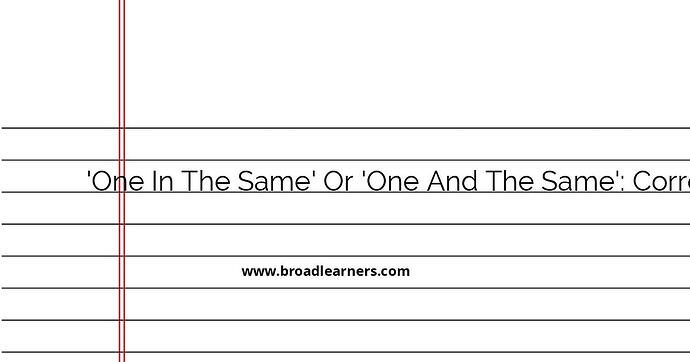Language can often be confusing, especially when phrases are misheard and used incorrectly. One such example is the debate over whether to use 'one in the same' or 'one and the same.' Understanding the correct usage of these phrases is crucial for maintaining clarity and accuracy in writing and speech. Let's delve into the correct phrase and explore some examples:
Correct Phrase: 'One and the Same'
The correct expression is 'one and the same.' This idiom is used to emphasize that two references are to a single entity, indicating that they are identical or indistinct from one another. The phrase is less about describing any number and more about illustrating the identity or sameness between two named aspects.
Why 'One and the Same'?
- Grammar Explanation:
- 'One and the same' is rooted in the idea of concerts demonstrating uniformity or identical essence. The ‘and’ conjunction combines the two terms ('one' and 'the same') to stress this unity or indistinguishability.
- Historical Context:
- The expression has been used for centuries to denote that different names or terms may actually refer to the same item or person, emphasizing their equivalency or sameness.
Examples:
"As it turns out, the CEO and the mystery investor were one and the same person all along."
"The supposed twin towns were one and the same, just divided by a mere county line."
"Despite their different names, the documents were one and the same, containing identical information."
Common Mistake: 'One in the Same'
The phrase 'one in the same' is often a mishearing of 'one and the same.' Although it may seem reasonable contextually, it is incorrect. The misinterpreted preposition 'in' does not logically connect the ideas of 'one' and 'the same' in legitimate grammatical constructions.
Common Misinterpretation:
Individuals who use 'one in the same' often mistakenly think it implies something or someone is part of the same category or group. While a plausible conception, it strays from correct idiomatic usage.
Example of Incorrect Usage:
- Incorrect: "I realized too late that the thief and my trusted advisor were one in the same."
- Corrected: "I realized too late that the thief and my trusted advisor were one and the same."
It’s beneficial to be vigilant and precision-oriented in our use of language. By sticking to the correct phrase, "one and the same," we keep our communications clear, showing an understanding of nuances that elevate the precision of our speech or writing.
Did I miss anything? Respond below
